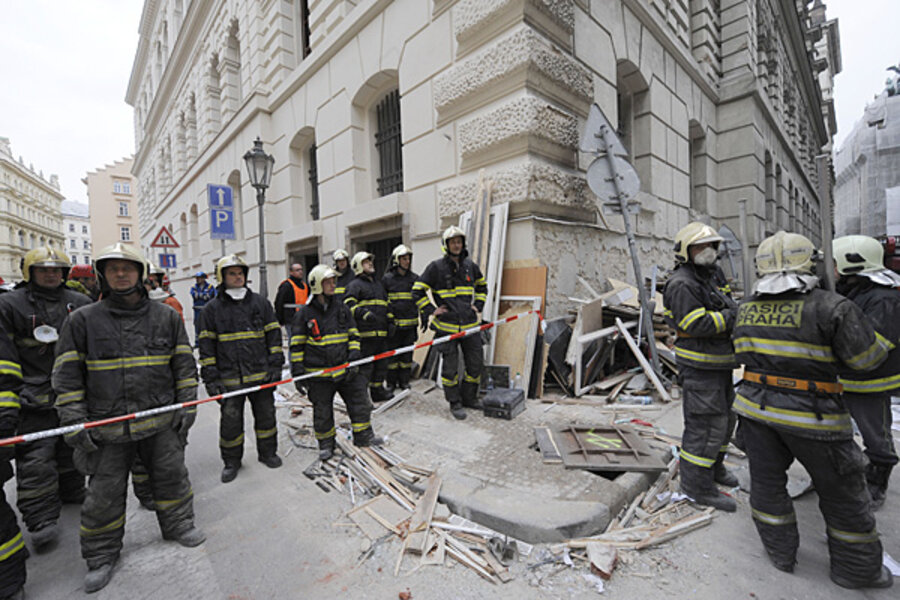Prague blast: How big a threat are natural gas explosions?
[Editor's note: This story has been updated.]
A powerful blast in central Prague early Monday shook the city and left 35 injured and at least two people missing. According to the Czech capital's mayor, it was the result of a leaky natural gas pipe.
A day earlier, an explosion probably linked to natural gas ripped through a five-story building in Reims, France, causing three fatalities and injuring 14 others. A methane gas blast last Monday at a wastewater treatment plant in Dexter, Mich., killed one worker and injured another.
Natural gas explosions offer a violent reminder of the extensive energy infrastructure beneath our feet. Although serious incidents are relatively rare, explosions are fairly common. When natural gas ignites, the results can be catastrophic. And as the United States increases its use of natural gas, the potential dangers expand.
"These are low-probability but high-impact events," said Nathan Phillips, a professor at Boston University’s Department of Earth and Environment, "but we have to think seriously about those kinds of events."
The explosion in a row of century-old buildings in downtown Prague shattered windows and spewed rubble into the street, according to the Associated Press. Authorities closed off an area around the site, stranding some tourists. Rescue crews with sniffer dogs searched the rubble and had not found any fatalities.
In the US, there are over 2.1 million miles of natural gas distribution pipelines, supplying a quarter of all the energy Americans consume. Roughly 27 serious incidents are reported each year on average, according to the Department of Transportation, resulting in an average of nine deaths, 45 injuries, and reported property damages totaling over $5.6 million.
A 2010 natural gas pipeline explosion in San Bruno, Calif., killed eight people and destroyed 37 homes. In 2011, a natural gas pipeline exploded in Allentown, Penn., killing five people and damaging 50 buildings.
But federal data doesn't represent the whole picture, said Frank Gallagher, editor and publisher of NaturalGasWatch.org, which compiles news reports of natural gas incidents, including those at smaller distribution lines that feed homes and businesses.
"Each municipality and each state has their own set of numbers," said Mr. Gallagher. "There’s no central clearinghouse of data."
The nation's aging energy infrastructure only exacerbates the issue. Over 12 percent of the nation’s cross-country gas transmission and hazardous liquid pipelines were built prior to the 1950s.
In major cities, particularly historic ones on the East Coast, corroding pipes and leaky joints can result in significant emissions.
Mr. Phillips was the lead author of a November 2012 study that found more than 3,000 leaks in the City of Boston's aging natural-gas pipeline system. Six of those leaks exceeded the threshold above which explosions can occur.
While most of these leaks don't pose an immediate threat, Phillips said more should be done to inform the public of the need to replace aging pipes.
"If I knew there was a 100-year-old pipe in front of my street, I’d be willing to pay a few extra cents every month on my gas bill for infrastructure improvements."
Natural gas leaks also contribute to heat-trapping emissions. Methane, a primary ingredient of natural gas, is the second most prevalent greenhouse gas emitted in the United States.
To combat these leaks, many natural gas providers invest heavily in pipeline repair or replacement projects. California-based Pacific Gas and Electric Co. plans to replace 270 miles of pipeline in San Francisco by the end of 2014. In Georgia, the Atlanta Gas Light Pipeline Replacement Program is a 15-year project to replace more than 2,700 miles of aging pipes with plastic and steel pipes. The project is scheduled for completion sometime in 2013.
And considering car accidents killed nearly 30,000 people in 2011, natural gas pipelines are not generally considered to be a widespread threat to public health.
But natural gas use is on the rise, matching coal in US power generation for the first time last July. Some say utility companies aren't keeping up with the country's rapidly-changing energy mix.
"We’ve hitched our wagon to the natural gas horse," Gallagher said, "but we don’t have the infrastructure to handle the load."






